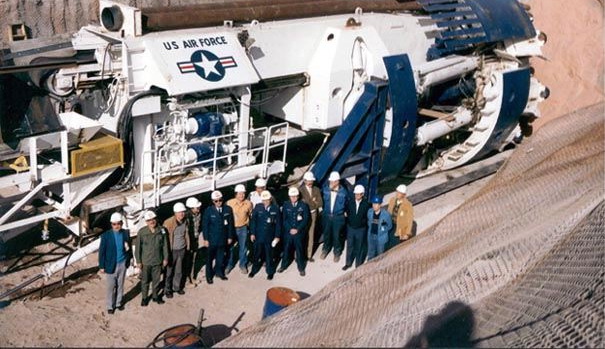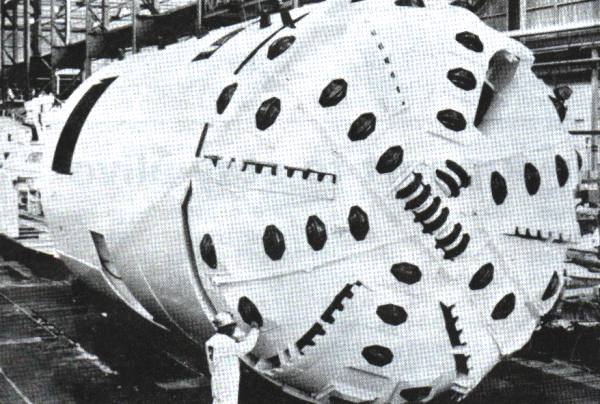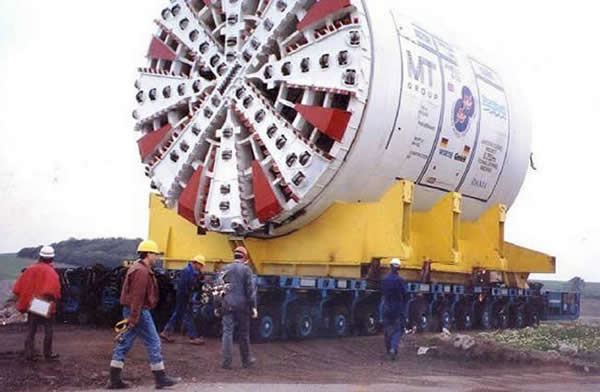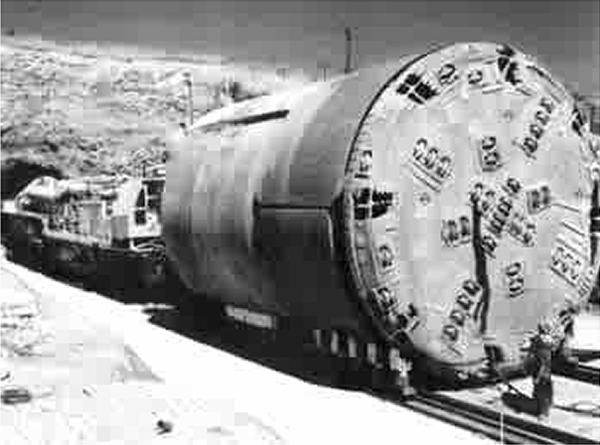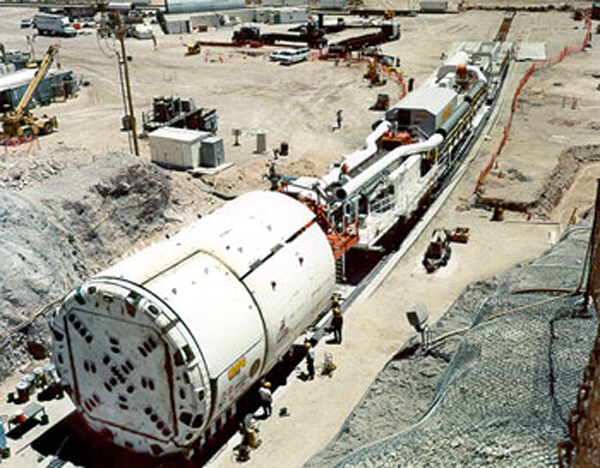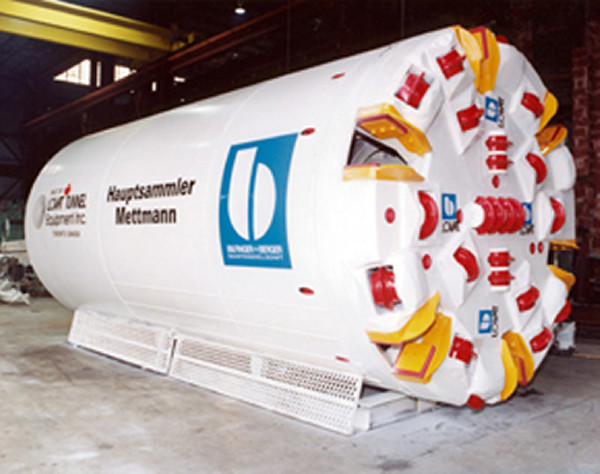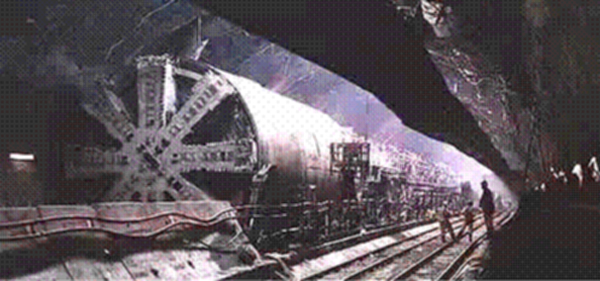Het eerste deel van deze pagina is geschreven door Phil Schneider:
Photo of United States Air Force tunnel boring machine at Little Skull Mountain, Nevada, USA, December 1982. Foto van de United States Air Force tunnel saai machine op Skull Little Mountain, Nevada, USA, december 1982. There are many rumors of secret military tunnels in the United States. Er zijn veel geruchten van geheime militaire tunnels in de Verenigde Staten. If the rumors are true, machines such as the one shown here are used to make the tunnels. (Source: US Department of Energy.) Als de geruchten waar zijn, de machines, zoals de hier getoonde worden gebruikt om de tunnels. (Bron: US Department of Energy.)
This is a $13 million tunnel boring machine (TBM) used for tunneling at the Nevada Test Site. Dit is een $ 13 miljoen tunnel boring machine (TBM) gebruikt voor tunneling op de Nevada Test Site. (Remember that Area 51 is part of the test site.) Many other types of TBMs are used by many government agencies, including the 'nuclear powered TBM' [NTBM] that melts solid rock and leaves behind glass-like walls. (Vergeet niet dat Area 51 is een onderdeel van de test-site.) Vele andere soorten TBMs worden gebruikt door tal van overheidsdiensten, waaronder de 'nucleaire aangedreven TBM' [NTBM] dat smelt stevige rock en achter glas-achtige muren.
Most tunneling activity is under military installations and all information is highly restricted. Former employees of said facilities have surfaced over the years to talk of massive underground installations in places like Area 51, the Northrop facility in Antelope Valley, California (rumored to have 42 levels), and the Lockheed installation near Edwards, California. Meest tunneling activiteit onder militaire installaties en alle informatie is zeer beperkt is. Voormalige medewerkers van de genoemde faciliteiten hebben voorgedaan in de loop der jaren te spreken over enorme ondergrondse installaties in plaatsen als Area 51, de Northrop faciliteit in Antelope Valley, California (rumored hebben 42 niveaus ) en de Lockheed-installatie vlakbij Edwards, Californië.
The 'Black Budget' currently consumes $1.25 trillion per year. De 'Zwarte Begroting momenteel verbruikt $ 1,25 biljoen per jaar. At least this amount is used in black programs, like those concerned with deep underground military bases. Ten minste dit bedrag wordt gebruikt in zwart-programma's, zoals die met betrekking tot de diepe ondergrondse militaire bases. Presently, there are 129 deep underground military bases in the United States. Momenteel zijn er 129 diepe ondergrondse militaire bases in de Verenigde Staten. They have been building these 129 bases day and night, unceasingly, since the early 1940's. Zij zijn de bouw van deze 129 basen dag en nacht, onophoudelijk, sinds het begin van de jaren 1940's. Some of them were built even earlier than that. Sommigen van hen werden zelfs eerder dan dat. These bases are basically large cities underground connected by high-speed magneto-leviton trains that have speeds up to Mach 2. Deze grondslagen zijn in feite de grote steden ondergronds verbonden door high-speed magneto-leviton treinen die snelheden tot Mach 2. Several books have been written about this activity. Verschillende boeken zijn geschreven over deze activiteit.
The average depth of these bases is over a mile, and they again are basically whole cities underground. De gemiddelde diepte van deze grondslagen is dan een kilometer, en ze opnieuw in wezen hele ondergrondse steden. They all are between 2.66 and 4.25 cubic miles in size. Ze zijn allemaal tussen de 2,66 en 4,25 kubieke kilometer in omvang. They have laser-drilling machines that can drill a tunnel seven miles long in one day. Ze hebben laser-boren machines die kunnen boren een tunnel zeven kilometer lang in een dag. I was involved in building an addition to the deep underground military base at Dulce, which is probably the deepest base. Ik was betrokken bij de opbouw van een toevoeging aan de diepe ondergrondse militaire basis op Dulce, dat is waarschijnlijk de diepste basis. It goes down seven levels and over 2.5 miles deep. Het gaat zeven niveaus en meer dan 2,5 kilometer diep. I helped hollow out more than 13 deep underground military bases in the United States. Ik hielp holle meer dan 13 diepe ondergrondse militaire bases in de Verenigde Staten.
_____________________________ _____________________________
More thought-provoking images of tunnel boring equipment: Meer dacht stimulerende beelden van de tunnel saai apparatuur: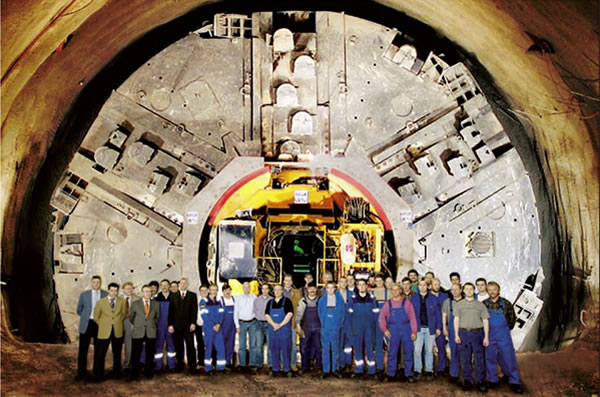
_____________________________ _____________________________
From Dr Bill Deagle's December 2006 Granada Forum Lecture : Van dr. Bill Deagle van december 2006 Granada Forum Lezing:
I took care of John Fialla, who was best friends with Phil Schneider. Ik nam de zorg van John Fialla, wie was het best bevriend met Phil Schneider. How many people know about Phil Schneider? Hoeveel mensen weten Phil Schneider? Well, they were using tunneling machines back in the mid-90s that could tunnel through a rock face at seven miles per day, that could cut through a rock face with high-energy impact lasers that could blow the nano-sized particles of rock so that there was no debris left, forming an obsidian-like core, and laying an inner core for unidirectional maglev trains that travel at Mach 2 to 2.8 underground between these very very powerful and organized cities. Nou, ze waren het gebruik van tunneling machines terug in het midden van de jaren'90 die tunnel door een rotswand op zeven kilometer per dag, dat zou kunnen besparen door een rotswand met een hoog-energetische impact lasers die klap van de nano-deeltjes grootte van rock dus dat er geen puin links, die een obsidiaan-achtige kern, en tot een innerlijke kern voor unidirectionele maglev treinen die rijden met Mach 2 tot 2,8 ondergrondse tussen deze zeer krachtige en goed georganiseerde steden.
There's 132 under the United States, an average of 5.36 to 7.24 cubic miles in size at an average of 1.5 to 4.5 miles underground, built, by and large, most of them in areas away from geotectonic areas - but there's going to be lots of new geotectonic faults established when you have force 11, 12, 13, 14 earthquakes hit the Earth. Er is 132 in het kader van de Verenigde Staten, een gemiddelde van 5,36 tot 7,24 kubieke kilometer in omvang, tegen een gemiddelde van 1,5 tot 4,5 kilometer ondergronds, gebouwd, en door de grote, de meeste van hen in gebieden ver van geotectonic gebieden - maar er gaat te veel nieuwe geotectonic gebreken geconstateerd wanneer u kracht 11, 12, 13, 14 aardbevingen getroffen de Aarde.Why are they rushing to do this? Waarom zijn ze haasten om dit te doen? Because they know that catastrophe is coming. Omdat ze weten dat catastrofe komt. And where's this money coming from? En waar is dit geld vandaan? It's not coming from our regular Black Op budget. Het is niet afkomstig van onze regelmatige Black Op begroting. It's coming from the illegal sale of drugs. Het is afkomstig van de illegale verkoop van drugs. In the United States there's at least, by conservative estimates, a quarter of a trillion to a half a trillion of illegal drugs just sold in the United States that goes directly into underground budgets, and 90-95% goes to the DUMBs [Deep Underground Military Bases] . In de Verenigde Staten is er op zijn minst door conservatieve schatting een kwart biljoen tot een half biljoen van illegale drugs alleen verkocht in de Verenigde Staten gaat rechtstreeks in ondergrondse budgetten, en 90-95% gaat naar de DUMBs [Deep Underground Militaire Basissen].
_____________________________ _____________________________
The following was written by Richard Sauder, PhD, adapted from his book Underground Bases and Tunnels : Het volgende is geschreven door Richard Sauder, PhD, aangepaste versie van zijn boek Underground Basissen en tunnels:
The nuclear subterrene (rhymes with 'submarine') was designed at the Los Alamos National Laboratory, in New Mexico. De nucleaire subterrene (rijmt met 'onderzeeër') is ontworpen op de Los Alamos National Laboratory in New Mexico. A number of patents were filed by scientists at Los Alamos, a few federal technical documents were written - and then the whole thing just sort of faded away. Een aantal octrooien werden ingediend door wetenschappers van Los Alamos, een enkele federale technische documenten werden geschreven - en dan het hele ding gewoon soort vervaagde weg.
Or did it? Of heeft het?
Nuclear subterrenes work by melting their way through the rock and soil, actually vitrifying it as they go, and leaving a neat, solidly glass-lined tunnel behind them. Nucleaire subterrenes werk door het smelten van hun weg door het gesteente en de bodem, eigenlijk vitrifying als ze gaan, en verlaten van een nette, stevig glas beklede tunnel achter hen.
The heat is supplied by a compact nuclear reactor that circulates liquid lithium from the reactor core to the tunnel face, where it melts the rock. De warmte wordt geleverd door een compacte kernreactor dat circuleert vloeibare lithium uit de reactorkern van de tunnel staan, waar het smelt de rots. In the process of melting the rock the lithium loses some of its heat. In het proces van het smelten van de rots de lithium verliest een deel van haar warmte. It is then circulated back along the exterior of the tunneling machine to help cool the vitrified rock as the tunneling machine forces its way forward. Het is daarna terug langs de buitenkant van de tunneling machine om te helpen het koelen van de verglaasd rock als de tunneling machine krachten zijn weg voorwaarts. The cooled lithium then circulates back to the reactor where the whole cycle starts over. De afgekoelde lithium circuleert vervolgens terug naar de reactor waar de hele cyclus begint voorbij. In this way the nuclear subterrene slices through the rock like a nuclear powered, 2,000 degree Fahrenheit (1,100 Celsius) earthworm, boring its way deep underground. Op deze manier worden de nucleaire subterrene plakjes door de rots als een nucleair aangedreven, 2000 graden Fahrenheit (1100 Celsius) aardworm, saai zijn weg diepe ondergrondse.
The United States Atomic Energy Commission and the United States Energy Research and Development Administration took out Patents in the 1970s for nuclear subterrenes. De Verenigde Staten Commissie voor Atoomenergie en de Verenigde Staten, Energy Research and Development Administration haalde patenten in de jaren 1970 voor nucleaire subterrenes. The first patent, in 1972 went to the US Atomic Energy Commission. Het eerste octrooi, in 1972 ging naar de Amerikaanse Commissie voor Atoomenergie.
The nuclear subterrene has an advantage over mechanical TBMs in that it produces no muck that must be disposed of by conveyors, trains, trucks, etc. This greatly simplifies tunneling. De nucleaire subterrene heeft een voordeel ten opzichte van mechanische TBMs in die zin dat zij geen bevuilen dat moet worden verwijderd door transportbanden, treinen, vrachtwagens, enz. Dit sterk vereenvoudigt tunneling. If nuclear subterrenes actually exist (and I do not know if they do) their presence, and the tunnels they make, could be very hard to detect, for the simple reason that there would not be the tell-tale muck piles or tailings dumps that are associated with the conventional tunneling activities. Als de nucleaire subterrenes daadwerkelijk bestaan (en ik weet niet of ze doen) hun aanwezigheid, en de tunnels die zij uitvoeren, kan zeer moeilijk op te sporen, om de eenvoudige reden dat er niet het verklikkerlicht Muck palen of tailings stortplaatsen die die worden geassocieerd met de conventionele tunneling activiteiten.
The 1972 patent makes this clear. De 1972 patent maakt dit duidelijk. It states: Het luidt als volgt:"... (D)ebris may be disposed of as melted rock both as a lining for the hole and as a dispersal in cracks produced in the surrounding rock. The rock-melting drill is of a shape and is propelled under sufficient pressure to produce and extend cracks in solid rock radially around the bore by means of hydrostatic pressure developed in the molten rock ahead of the advancing rock drill penetrator. All melt not used in glass-lining the bore is forced into the cracks where it freezes and remains ... "... (D) ebris kan worden verwijderd als gesmolten gesteente als een voering voor het gat en als verspreiding in scheuren in het omliggende gesteente. De rock-smeltend boor is van een vorm en wordt voortgestuwd onder voldoende druk uit te produceren en uit te breiden scheuren in vaste rots radiaal rond de boring door middel van hydrostatische druk in het gesmolten gesteente voorsprong van de oprukkende rock drill penetrator. Alle smelt niet gebruikt wordt in glas-voering van de boring wordt gedwongen in de scheuren wanneer het bevriest en blijft. ..
"... Such a (vitreous) lining eliminates, in most cases, the expensive and cumbersome problem of debris elimination and at the same time achieves the advantage of a casing type of bore hole liner." "... Zo'n (glazig) voering elimineert, in de meeste gevallen is de duur en lastig probleem van puin wegwerken en tegelijkertijd wordt het voordeel van een behuizing type boring gat lijnvaartsector."( US Patent No. 3,693,731 dated Sept. 26, 1972 ) (US Patent nr. 3693731 dd sept 26, 1972)
There you have it: a tunneling machine that creates no muck, and leaves a smooth, vitreous (glassy) tunnel lining behind. Daar heb je het: een tunneling machine die schept geen bevuilen, en laat een glad, glazig (glasachtig) tunnel voering achter.
Another patent three years later was for: Een ander octrooi drie jaar later werd voor:A tunneling machine for producing large tunnels in soft rock or wet, clayey, unconsolidated or bouldery earth by simultaneously detaching the tunnel core by thermal melting a boundary kerf into the tunnel face and forming a supporting excavation wall liner by deflecting the molten materials against the excavation walls to provide, when solidified, a continuous wall supporting liner, and detaching the tunnel face circumscribed by the kerf with powered mechanical earth detachment means and in which the heat required for melting the kerf and liner material is provided by a compact nuclear reactor. Een tunneling machine voor de productie van grote tunnels in zachte steen of nat, lemig, niet-geconsolideerde of bouldery aarde door tegelijkertijd detacheren de tunnel kern door thermische smelt een grens zaagsnede in de tunnel gezicht en de vorming van een ondersteunende opgraving muur lijnvaartsector door deflecting het gesmolten materiaal tegen de opgraving muren om, wanneer solidified, een continue wand ondersteunen lijnvaartsector en detacheren de tunnel gezicht afgebakend door de zaagsnede met aangedreven mechanische aarde losmaking betekent en waarin de warmte die nodig is voor het smelten van de zaagsnede en liner materiaal wordt geleverd door een compacte kernreactor.
This 1975 patent further specifies that the machine is intended to excavate tunnels up to 12 meters in diameter or more. Dit octrooi 1975 bepaald dat de machine is bedoeld om tunnels uitgraven tot 12 meter in diameter of meer. This means tunnels of 40 ft. or more in diameter. The kerf is the outside boundary of the tunnel wall that a boring machine gouges out as it bores through the ground or rock. Dit betekent dat de tunnels van 40 meter of meer in diameter. De zaagsnede is de grens van buiten de tunnel wand dat een saaie machine gouges als het bores door de bodem of rock. So, in ordinary English, this machine will melt a circular boundary into the tunnel face. Dus, in gewoon Engels, deze machine zal smelten een circulaire grens in de tunnel gezicht. The melted rock will be forced to the outside of the tunnel by the tunnel machine, where it will form a hard, glassy tunnel lining (see the appropriate detail in the patent itself, as shown in Illustration 41). De gesmolten rots zal gedwongen worden om de buitenkant van de tunnel door de tunnel machine, waar het zal een harde, glasachtig tunnel voering (zie de nodige details in het octrooi zelf, zoals weergegeven in Afbeelding 41). At the same time, mechanical tunnel boring equipment will grind up the rock and soil detached by the melted kerf and pass it to the rear of the machine for disposal by conveyor, slurry pipeline, etc. Tegelijkertijd mechanische tunnel saai materiaal zal slijpen van de steen en bodem losgekomen door de gesmolten zaagsnede en doorgeven aan de achterzijde van de machine voor het verwijderen van transportband, drijfmest pijpleiding, enz.
And yet a third patent was issued to the United States Energy Research and Development Administration just 21 days later, on 27 May 1975 for a machine remarkably similar to the machine patented on 6 May 1975. En nog een derde octrooi werd afgegeven aan de Verenigde Staten Energy Research and Development Administration slechts 21 dagen later, op 27 mei 1975 voor een machine opvallend vergelijkbaar met de machine gepatenteerde op 6 mei 1975. The abstract describes: De abstracte beschrijft:A tunneling machine for producing large tunnels in rock by progressive detachment of the tunnel core by thermal melting a boundary kerf into the tunnel face and simultaneously forming an initial tunnel wall support by deflecting the molten materials against the tunnel walls to provide, when solidified, a continuous liner; and fragmenting the tunnel core circumscribed by the kerf by thermal stress fracturing and in which the heat required for such operations is supplied by a compact nuclear reactor. Een tunneling machine voor de productie van grote tunnels in progressieve rock door loslating van de tunnel kern door thermische smelt een grens zaagsnede in de tunnel gezicht en tegelijkertijd de vorming van een eerste tunnelwand ondersteuning door deflecting het gesmolten materiaal tegen de tunnel muren om, wanneer solidified, een continue lijnvaartsector en fragmentatie van de tunnel kern afgebakend door de zaagsnede door thermische stress breken en waarbij de warmte die nodig is voor dergelijke operaties wordt geleverd door een compacte kernreactor.
This machine would also be capable of making a glass-lined tunnel of 40 ft. in diameter or more. Deze machine zou ook kunnen maken van een glas beklede tunnel van 40 meter in diameter of meer.
Perhaps some of my readers have heard the same rumors that I have heard swirling in the UFO literature and on the UFO grapevine: stories of deep, secret, glass-walled tunnels excavated by laser powered tunneling machines. Misschien dat sommige van mijn lezers hebben gehoord dezelfde geruchten die ik heb gehoord zwenken in de UFO-literatuur en over de UFO grapevine: verhalen van diepe, geheime, glas-ommuurde tunnels uitgegraven door laser powered tunneling machines. I do not know if these stories are true. If they are, however, it may be that the glass-walled tunnels are made by the nuclear subterrenes described in these patents. Ik weet niet of deze verhalen kloppen. Als er verschillen zijn, maar het kan zijn dat de glazen wand tunnels zijn gemaakt door de nucleaire subterrenes beschreven in deze octrooien. The careful reader will note that all of these patents were obtained by agencies of the United States government. De zorgvuldige lezer zal merken dat al deze octrooien zijn verkregen door agentschappen van de Verenigde Staten de overheid. Further, all but one of the inventors are from Los Alamos, New Mexico. Verder zijn alle maar een van de uitvinders zijn van Los Alamos, New Mexico. Of course, Los Alamos National Lab is itself the subject of considerable rumors about underground tunnels and chambers, Little Greys or "EBEs", and various other covert goings-on. Natuurlijk, Los Alamos National Lab is zelf het voorwerp van aanzienlijke geruchten over ondergrondse tunnels en kamers, Little Greys of "EBES", en diverse andere geheime affaire op.
A 1973 Los Alamos study entitled Systems and Cost Analysis for a Nuclear Subterrene Tunneling Machine: A Preliminary Study , concluded that nuclear subterrene tunneling machines (NSTMs) would be very cost effective, compared to conventional TBMs. Een 1973 Los Alamos studie getiteld Systems and Cost Analysis voor een nucleair Subterrene Tunneling Machine: een inleidende studie concludeerde dat de nucleaire subterrene tunneling machines (NSTMs) zou zeer kosteneffectief, vergeleken met conventionele TBMs.It stated: Hij verklaarde:
Tunneling costs for NSTMs are very close to those for TBMs, if operating conditions for TBMs are favorable. Tunneling kosten voor NSTMs zijn zeer dicht bij die voor TBMs, indien bedrijfsomstandigheden voor TBMs gunstig. However, for variable formations and unfavorable conditions such as soft, wet, bouldery ground or very hard rock, the NSTMs are far more effective. Echter, voor variabele formaties en ongunstige omstandigheden, zoals zachte, natte, bouldery grond of heel hard rock, de NSTMs zijn veel effectiever. Estimates of cost and percentage use of NSTMs to satisfy US transportation tunnel demands indicate a potential cost savings of 850 million dollars (1969 dollars) throughout 1990. Schattingen van kosten en het percentage gebruik van NSTMs aan Amerikaanse transport tunnel eisen geven een potentiële besparing van 850 miljoen dollar (1969 dollar) in 1990. An estimated NSTM prototype demonstration cost of $100 million over an eight-year period results in a favorable benefit-to-cost ratio of 8.5. Naar schatting NSTM prototype demonstratie kosten van $ 100 miljoen over een periode van acht jaar leidt tot een gunstige baten-op-kosten-verhouding van 8,5.
...Was the 1973 feasibility study only idle speculation, and is the astonishingly similar patent two years later only a wild coincidence? ... Was de 1973 haalbaarheidsstudie alleen stationair speculatie, en is het verbazingwekkend soortgelijk octrooi twee jaar later slechts een wilde toeval? As many a frustrated inventor will tell you, the US Patent Office only issues the paperwork when it's satisfied that the thing in question actually works! Zoals velen een gefrustreerde uitvinder zal u vertellen, het US Patent Office alleen kwesties het papierwerk wanneer het ervan overtuigd dat het ding in kwestie werkelijk werkt!
In 1975 the National Science Foundation commissioned another cost analysis of the nuclear subterrene. In 1975 de National Science Foundation in opdracht een nieuwe kosten-analyse van de nucleaire subterrene. The AA Mathews Construction and Engineering Company of Rockville, Maryland produced a comprehensive report with two, separate, lengthy appendices, one 235 and the other 328 pages. De AA Mathews Construction and Engineering Company van Rockville, Maryland een uitgebreid verslag met twee afzonderlijke, lange aanhangsels, een 235 en de andere 328 pagina's.
AA Mathews calculated costs for constructing three different sized tunnels in the Southern California area in 1974. AA Mathews berekende kosten voor de bouw van drie verschillende grootte tunnels in het Zuid-Californië in 1974. The three tunnel diameters were: De drie tunneldiameters waren:a) 3.05 meters (10 ft.) a) 3,05 meter (10 ft)
b) 4.73 meters (15.5 ft.) b) 4,73 meter (15.5 ft)c) 6.25 meters (20.5 ft.) c) 6,25 meter (20,5 ft)
Comparing the cost of using NSTMs to the cost of mechanical TBMs, AA Mathews determined: Vergelijking van de kosten van het gebruik van NSTMs aan de kosten van mechanische TBMs, AA Mathews bepaald:
Savings of 12 percent for the 4.73 meter (15.5 ft.) tunnel and 6 percent for the 6.25 meter (20.5 foot) tunnel were found to be possible using the NSTM as compared to current methods. Besparing van 12 procent voor de 4,73 meter (15,5 ft) tunnel en 6 procent van de 6,25 meter (20,5 voet) tunnel gevonden te kunnen worden met behulp van de NSTM in vergelijking met de huidige methoden. A penalty of 30 percent was found for the 3.05 meter (10 foot) tunnel using the NSTM. Een boete van 30 procent werd gevonden voor de 3,05 meter (10 voet) tunnel via de NSTM. The cost advantage for the NSTM results from the combination of, De kosten voordeel voor de NSTM resultaten uit de combinatie van
(a) a capital rather than labor intensive system, (a) een kapitaal dan arbeidsintensief systeem,
(b) formation of both initial support and final lining in conjunction with the excavation process. (b) vorming van zowel de initiële ondersteuning en laatste bekleding in combinatie met de opgraving proces.
This report has a number of interesting features. Dit verslag heeft een aantal interessante functies. It is noteworthy in the first place that the government commissioned such a lengthy and detailed analysis of the cost of operating a nuclear subterrenes. Opmerkelijk is in de eerste plaats dat de regering opdracht gegeven een dergelijke lange en gedetailleerde analyse van de kosten van de exploitatie van een nucleaire subterrenes. Just as intriguing is the fact that the study found that the tunnels in the 15 ft. to 20 ft. diameter range can be more economically excavated by NSTMs than by conventional TBMs. Net als intrigerend is het feit dat de studie bleek dat de tunnels in de 15 ft tot 20 ft diameter kan meer economisch opgegraven door NSTMs dan door conventionele TBMs.
Finally, the southern Californ
Bron: projectcamelot
